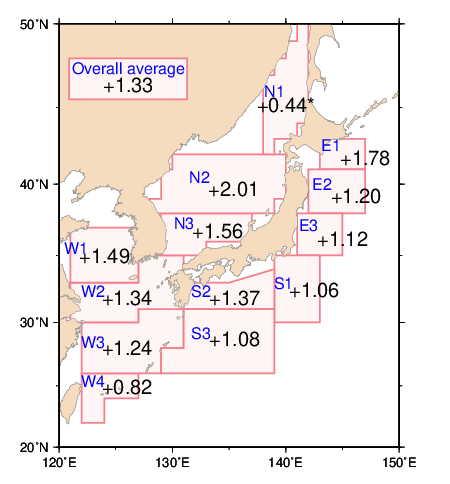Sea surface temperature (around Japan)
Updated on 5 Mar. 2025
Japan Meteorological Agency
The annual average sea surface temperature (SST) around Japan has risen by +1.33°C over the last 100 years, which exceeds the corresponding figure for the global ocean (+0.62°C) and is similar to that for surface air temperature in Japan (+1.40°C). The rates of increase in Areas N3, S2, W1, W2 and W3 (see the table below) are also similar to those for surface air temperature in Japan, while those for Areas N1, E2, E3, S1, S3 and W4 are lower and those for Areas N2 and E1 are higher.

|
|
Increase rates of area-averaged annual mean SSTs around Japan from 1900 to 2024 (°C per century)
Areas with no symbol and those marked with [∗] have statistically significant trend at the confidence levels of 99 % and 95 %.
Commentary
The annual average SST around Japan has risen by +1.33°C over the last 100 years, which exceeds the corresponding figure for the global ocean and the North Pacific (+0.62 and +0.65°C, respectively) and is similar to that for surface air temperature in Japan (+1.40°C). The rates of increase in regional annual mean SSTs in Areas N3, S2, W1, W2 and W3 (see the table above) are similar to those for surface air temperature in Japan, while those for Areas N1, E2, E3, S1, S3 and W4 are lower and those for Areas N2 and E1 are higher.
According to the Sixth Assessment Report of the Intergovernmental Panel on Climate Change (IPCC AR6) Working Group I, it is unequivocal that human influence has warmed the atmosphere, ocean and land. As detailed in the IPCC AR6 Working Group I Report, observed changes in surface temperatures since 1850-1900 show significant variations among regions and have increased faster over land than over the oceans. The global warming is considered to have contributed to the SST increase around Japan. In addition to that, natural fluctuations such as Pacific Decadal Oscillation (PDO) and variations in the Kuroshio Extension are also thought to have contributed to the rising SST trend observed around Japan.
Data file download
All text file sizes are about 6KB.
| Area number | Area name | Data file |
|---|---|---|
| Overall | Overall | [text file] |
| N1 | Northeastern part of the Sea of Japan | [text file] |
| N2 | Central part of the Sea of Japan | [text file] |
| N3 | Southwestern part of the Sea of Japan | [text file] |
| E1 | Sea off Kushiro | [text file] |
| E2 | Sea off Sanriku | [text file] |
| E3 | Eastern part of the sea off Kanto | [text file] |
| S1 | Southern part of the sea off Kanto | [text file] |
| S2 | Sea off Shikoku and Tokai | [text file] |
| S3 | East of Okinawa | [text file] |
| W1 | Yellow Sea | [text file] |
| W2 | Northern part of the East China Sea | [text file] |
| W3 | Southern part of the East China Sea | [text file] |
| W4 | Sea around the Sakishima Islands | [text file] |